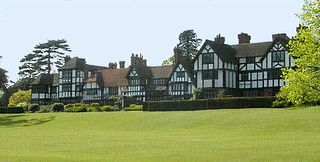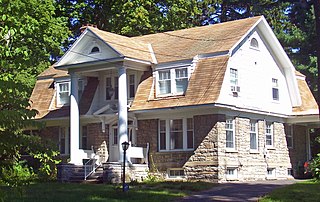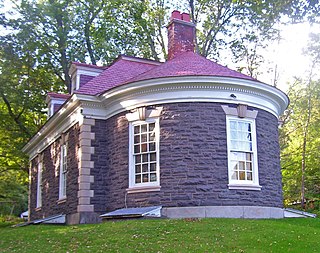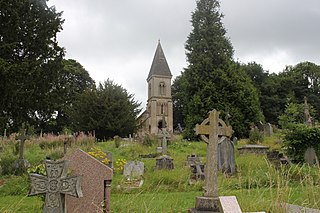
Tudor Revival architecture first manifested itself in domestic architecture in the United Kingdom in the latter half of the 19th century. Based on revival of aspects that were perceived as Tudor architecture, in reality it usually took the style of English vernacular architecture of the Middle Ages that had survived into the Tudor period. The style later became an influence elsewhere, especially the British colonies. For example, in New Zealand, the architect Francis Petre adapted the style for the local climate. In Singapore, then a British colony, architects such as R. A. J. Bidwell pioneered what became known as the Black and White House. The earliest examples of the style originate with the works of such eminent architects as Norman Shaw and George Devey, in what at the time was considered Neo-Tudor design.

Christ Episcopal Church is a historic Episcopal church located at 43 South Broadway in Tarrytown, New York. Topped by a modest tower, the ivy-covered red brick church was built in 1837 and maintains an active congregation to the present day. The church also includes the San Marcos Mission, a Spanish-language ministry.

The Potter–Collyer House is a historic house at 67 Cedar Street in Pawtucket, Rhode Island. The house, first constructed in 1863, is representative of vernacular architecture of the Pawtucket due to the great modifications to the home which has obscured the original structure of the home. Believed to have begun as a 1+1⁄2-story cottage with a gable roof, subsequent additions and expansions have added a two-story hip-roof addition and greatly altered the floor plan due to enlargement and remodeling. The Potter–Collyer House was added to the National Register of Historic Places in 1983.

The Dodge-Greenleaf House is on NY 211 in Otisville, New York, United States. It was built circa 1855 in the Gothic Revival style. The architect is unknown but it exemplifies contemporary trends in home design popularized by the writings and pattern books of Andrew Jackson Downing of nearby Newburgh, as articulated in the Picturesque mode.

Daniel Pabst was a German-born American cabinetmaker of the Victorian Era. He is credited with some of the most extraordinary custom interiors and hand-crafted furniture in the United States. Sometimes working in collaboration with architect Frank Furness (1839–1912), he made pieces in the Renaissance Revival, Neo-Grec, Modern Gothic, and Colonial Revival styles. Examples of his work are in the collections of the Metropolitan Museum of Art, the Philadelphia Museum of Art, the Art Institute of Chicago, and the Victoria and Albert Museum in London.

Zion Memorial Chapel, now known as St. Nicholas-on-the-Hudson, is an historic Carpenter Gothic style Episcopal church building located at 37 Point Street in New Hamburg, New York, United States. It was built in 1902 as a chapel of nearby Zion Church in Wappingers Falls and became a separate parish in 1983.

Maple Lawn, also known as the Walter Vail House, is a residence in Balmville, New York, United States built in the Gothic Revival architectural style's Picturesque mode. It was designed by Frederick Clarke Withers, following principles of his late mentor, Andrew Jackson Downing, and commissioned by a wealthy local family in 1859.
Leland Castle is a building in New Rochelle, New York. It was constructed during the years in 1855 - 1859 in the Gothic Revival style, and was the country residence of Simeon Leland, a wealthy New York City hotel proprietor. Leland began to assemble an estate as early as 1848, and in 1855, began the erection of this palatial 60-room mansion. The home was designed by New York City architect William Thomas Beers. A north and south wing were added to the castle in 1899 and 1902 respectively.

The former Vassar Home for Aged Men is located at Main and Vassar streets in Poughkeepsie, New York, United States. It is just across the street from the architecturally similar Vassar Institute, and both buildings are credited to architect J.A. Wood. In the 1970s it became the Cunneen-Hackett Arts Center.

St. James' Chapel is located on East Market Street, a short distance east of US 9, in Hyde Park, New York, United States. It is part of the Episcopal parish of St. James, whose main church is located 1 mile (1.6 km) north of it along Route 9.

The Gerard Crane House is a private home located on Somerstown Turnpike opposite Old Croton Falls Road in Somers, New York, United States. It is a stone house dating to the mid-19th century, built by an early circus entrepreneur in his later years.

The Tousley-Church House is located on North Main Street in Albion, New York, United States. It is a brick house in the Greek Revival architectural style built in two different stages in the mid-19th century.

The Richmond Memorial Library is located on Ross Street in Batavia, New York, United States. It is an 1880s stone structure in the Richardsonian Romanesque style designed by Rochester architect James Goold Cutler.

St. Peter's Episcopal Church of Peekskill, New York, United States, is located on the north edge of the city's downtown. It is a three-building complex of stone Late Gothic Revival buildings on a half-acre dating to the late 19th century and added onto at successive later dates.

The George Felpel House is located on NY 9H in Claverack-Red Mills, New York, United States. It is a stone Colonial Revival and Dutch Colonial Revival house built in the 1920s.

Morton Memorial Library is located on Elm Street in Pine Hill, New York, United States. It is a stone building in the Georgian Revival architectural style built at the beginning of the 20th century.

The Skene Memorial Library is located on Main Street in Fleischmanns, New York, United States. It is also used as the village hall. The frame building, combining elements of the Queen Anne and Shingle architectural styles, dates to the early 20th century. Its exterior incorporates aspects of local train station architecture.

The Anglican Bath Abbey Cemetery, officially dedicated as the Cemetery of St Peter and St Paul, was laid out by noted cemetery designer and landscape architect John Claudius Loudon (1783–1843) between 1843 and 1844 on a picturesque hillside site overlooking Bath, Somerset, England.

Cattermole Memorial Library is a historic building located in Fort Madison, Iowa, United States. It was individually listed on the National Register of Historic Places in 1984. In 2007 it was included as a contributing property in the Fort Madison Downtown Commercial Historic District.

Fitzroy House is a Victorian building on the High Street in Lewes, East Sussex, England. It was originally Fitzroy Memorial Library, designed by architect George Gilbert Scott in neo-Gothic style and built in 1862. In 1897 it became Lewes' first public library, until 1956 when it became offices. It was left empty and decaying for 20 years before being renovated and used as a family home for 40 years, as well as an occasional venue for music and theater. In 2016 it was sold. The main focal point of the house is the double-height Octagon Room.





















